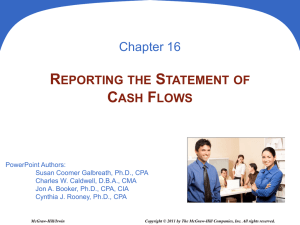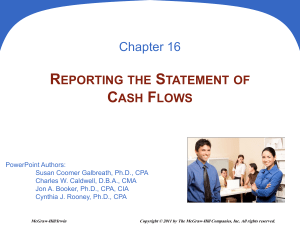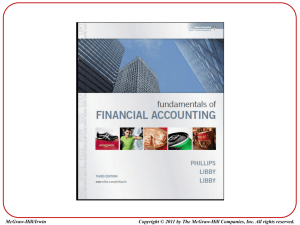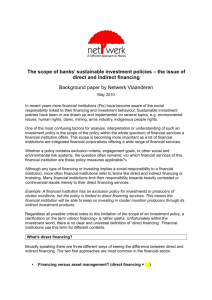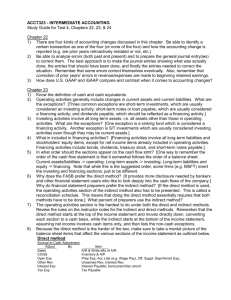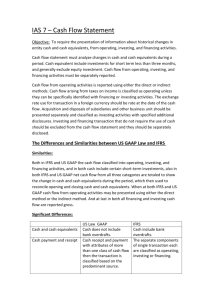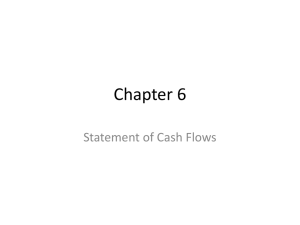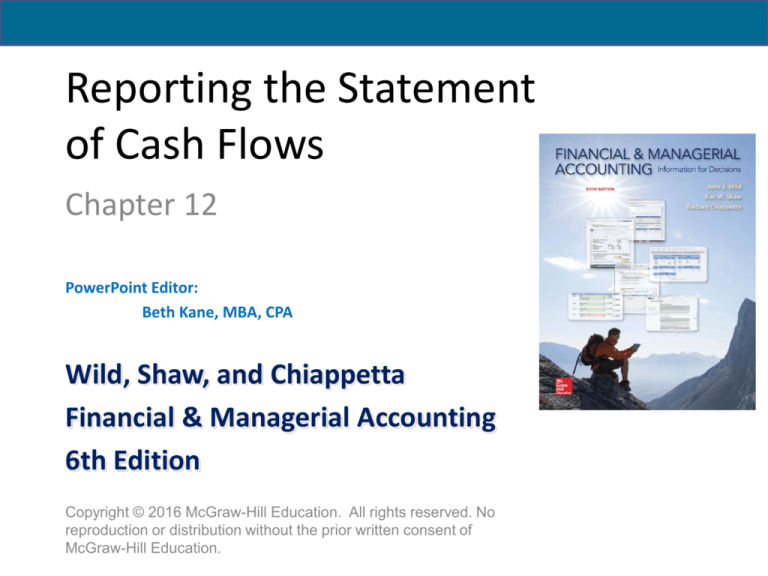
Reporting the Statement
of Cash Flows
Chapter 12
PowerPoint Editor:
Beth Kane, MBA, CPA
Wild, Shaw, and Chiappetta
Financial & Managerial Accounting
6th Edition
Copyright © 2016 McGraw-Hill Education. All rights reserved. No
reproduction or distribution without the prior written consent of
McGraw-Hill Education.
Purpose of the Statement
of Cash Flows
How does a
company receive its
cash?
Where does a
company spend its
cash?
What explains the
change in the cash
balance?
2
Importance of Cash Flows
What explains the
change in the cash
balance?
Where does a
company spend its
cash?
How does a
company receive its
cash?
Why do income and
cash flows differ?
3
Measurement of Cash Flows
Cash equivalents are…
short-term, highly liquid
investments.
readily convertible into cash.
sufficiently close to maturity
so that market value is
unaffected by interest rate
changes.
4
Classification of Cash Flows
The Statement of Cash Flows includes the
following three sections:
– Operating Activities
– Investing Activities
– Financing Activities
C1
5
Operating Activities
C1
6
Investing Activities
C1
7
Financing Activities
C1
8
Noncash Investing and Financing
Examples of Noncash Investing and Financing Activities
C1
9
Format of the Statement
of Cash Flows
P1
10
Preparing the Statement
of Cash Flows
P1
11
Analyzing the Cash Account
The Cash account is a natural place to look for
information about cash flows from operating, investing,
and financing activities.
P1
12
Analyzing Noncash Account
A second approach to preparing the statement
of cash flows is analyzing noncash accounts.
P1
13
Information to Prepare the
Statement
Information to prepare the statement of cash
flows usually comes from three sources:
Comparative
Balance Sheets
Current
Income Statement
Additional
Information
P1
14
Cash Flows from Operating
Indirect and Direct Methods of Reporting
Direct
Method
Indirect
Method
P1
The net cash amount provided by operating activities is
identical under both the direct and indirect methods. 15
These financial statements will
help us prepare the statement
of cash flows for Genesis
using the indirect method.
16
Applying the
Indirect Method of Reporting
Additional information on Genesis Inc.’s 2015 transactions:
a. The accounts payable balances result from inventory
purchases.
b. Purchased $60,000 in plant assets by issuing $60,000 of
notes payable.
c. Sold plant assets with a book value of $8,000 (original
cost of $20,000 and accumulated depreciation of
$12,000) for $2,000 cash, yielding a $6,000 loss.
d. Received $15,000 cash from issuing 3,000 shares of
common stock.
e. Paid $18,000 cash to retire notes with a $34,000 book
value, yielding a $16,000 gain.
f. Declared and paid cash dividends of $14,000.
P2
17
Applying the
Indirect Method of Reporting
Changes in noncash
current assets and current
liabilities
1
Net
Income
2
+ Noncash
expenses such as
depreciation and
amortization
P2
Cash Flows
from Operating
Activities
3
+ Losses and
- Gains
18
Adjustments for Changes in
Current Assets and Current Liabilities
Current
Assets
Current
Liabilities
Change in Account Balance During Year
Increase
Decrease
Subtract from net
Add to net income.
income.
Add to net income.
Subtract from net
income.
Use this table when adjusting Net Income
to Operating Cash Flows.
P2
19
Adjustments for Changes in
Current Assets and Current Liabilities
P2
20
Adjustments for Operating Items
Not Providing or Using Cash
P2
21
Adjustments for Nonoperating Items
P2
22
Summary of Adjustments
for Indirect Method
Common adjustments to net income when computing net cash provided
or used by operating activities under the indirect method:
P2
23
Cash Flows from Investing
A three-stage process to determine cash
provided or used by investing activities:
Identify changes in
investing-related
accounts
Explain these changes
using reconstruction
analysis
Report their cash flow
effects
P3
24
Cash Flows from Investing
This analysis reveals a
$40,000 increase in plant
assets from $210,000 to
$250,000 and a $12,000
increase in accumulated
depreciation from $48,000 to
$60,000.
P3
25
Cash Flows from Investing
Item b: Genesis purchased plant assets of $60,000 by issuing
$60,000 in notes payable to the seller.
Item c reports that Genesis sold plant assets costing $20,000 (with
$12,000 of accumulated depreciation) for $2,000 cash, resulting in a
$6,000 loss.
We also reconstruct the entry for Depreciation Expense using
information from the income statement.
P3
26
Cash Flows from Financing
A three-stage process to determine cash
provided or used by financing activities:
Identify changes in
financing-related
accounts
Explain these changes
using reconstruction
analysis
Report their cash
flow effects
P3
27
Cash Flows from Financing
This analysis reveals:
1. an increase in
notes payable
from $64,000 to
$90,000.
P3
28
Cash Flows from Financing
Item e: Notes with a carrying value of $34,000 are retired for $18,000
cash, resulting in a $16,000 gain.
P3
29
Cash Flows from Financing
Item d: Issued 3,000 shares of common stock at par for $5 per share.
Item f: Cash dividends of $14,000 are paid.
P3
30
P3
31
Overall Summary Using T-Accounts
P3
32
Global View
Reporting Cash Flows from Operating
Both U.S. GAAP and IFRS permit the reporting of cash flows from operating activities
using either the direct or indirect method. However, two notable differences include:
1. U.S. GAAP requires cash inflows from interest revenue and dividend revenue be
classified as operating, whereas IFRS permits classification under operating or
investing provided that this classification is consistently applied across periods.
2. U.S. GAAP requires cash outflows for interest expense be classified as operating,
whereas IFRS again permits classification under operating or financing provided
that it is consistently applied across periods.
Reporting Cash Flows from Investing and Financing
U.S. GAAP and IFRS are broadly similar in computing and classifying cash flows from
investing and financing activities. One notable exception is that U.S. GAAP requires
cash outflows for income tax be classified as operating, whereas IFRS permits the
splitting of those cash flows among operating, investing, and financing depending on
33
the sources of that tax.
Analyzing Cash
Sources and Uses
Most managers stress the importance of
understanding and predicting cash flows for business
decisions.
A1
34
Cash Flow on Total Assets
Used, along with income-based ratios, to
assess company performance.
Cash flow on
total assets
A1
=
Operating cash flows
Average total assets
35
Appendix 12A:
Spreadsheet
Preparation of the
Statement of Cash
Flows
A spreadsheet, also
called work sheet or
working paper, can
help us organize the
information needed
to prepare a
statement of cash
flows.
P4
36
Appendix 12B: Direct Method of Reporting Operating
Cash Flows
Adjust income statement accounts related to operating activities
for changes in their related balance sheet accounts:
Framework for
reporting cash
receipts and
cash payments
P5
37
Appendix 12B: Direct Method of Reporting Operating
Cash Flows
P5
38




